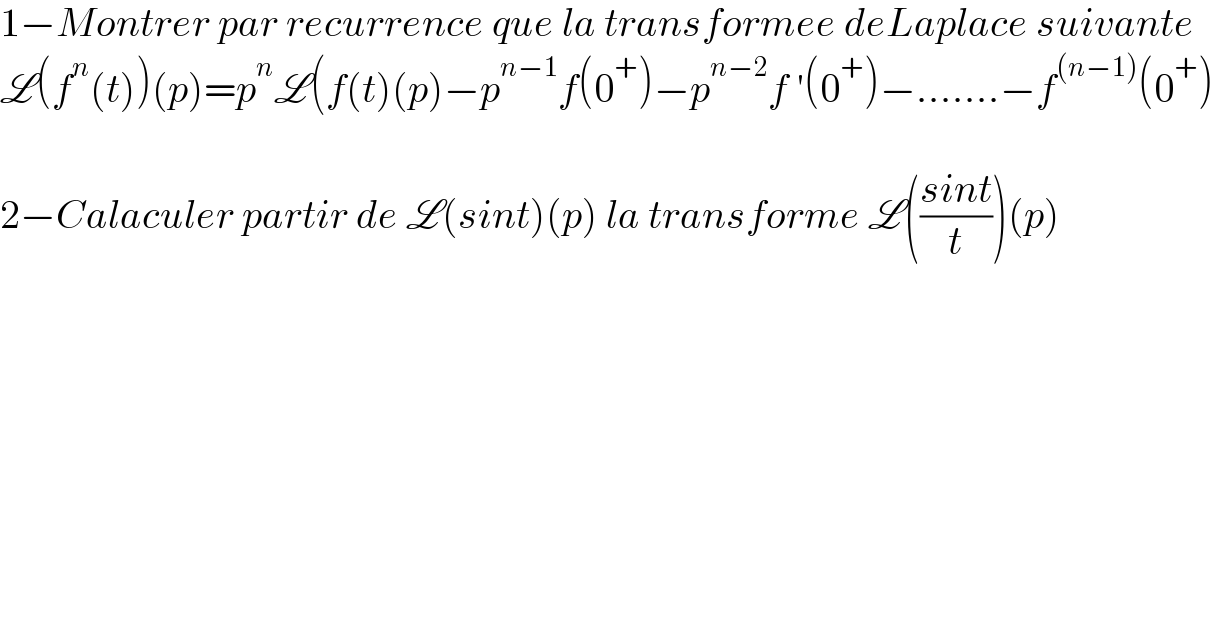
Question Number 143481 by lapache last updated on 15/Jun/21

$$\mathrm{1}−{Montrer}\:{par}\:{recurrence}\:{que}\:{la}\:{transformee}\:{deLaplace}\:{suivante} \\ $$$$\mathscr{L}\left({f}^{{n}} \left({t}\right)\right)\left({p}\right)={p}^{{n}} \mathscr{L}\left({f}\left({t}\right)\left({p}\right)−{p}^{{n}−\mathrm{1}} {f}\left(\mathrm{0}^{+} \right)−{p}^{{n}−\mathrm{2}} {f}\:'\left(\mathrm{0}^{+} \right)−.......−{f}^{\left({n}−\mathrm{1}\right)} \left(\mathrm{0}^{+} \right)\right. \\ $$$$ \\ $$$$\mathrm{2}−{Calaculer}\:{partir}\:{de}\:\mathscr{L}\left({sint}\right)\left({p}\right)\:{la}\:{transforme}\:\mathscr{L}\left(\frac{{sint}}{{t}}\right)\left({p}\right) \\ $$
Commented by Ar Brandon last updated on 15/Jun/21

$$\mathrm{Non}\:\mathrm{non}.\:\mathrm{Nous}\:\mathrm{n}'\mathrm{allons}\:\mathrm{pas}\:\mathrm{montrer}\:\mathrm{cela}. \\ $$😝
Commented by lapache last updated on 15/Jun/21

$${Alors}\:{que}\:{c}'{est}\:{meme}\:{ce}\:{que}\:{je}\:{veux} \\ $$
Commented by Ar Brandon last updated on 15/Jun/21

$$\mathrm{Mais}\: ext{\c{c}} \mathrm{ca}\:\mathrm{a}\:\acute {\mathrm{e}t}\acute {\mathrm{e}}\:\mathrm{fait}.\:\mathrm{Juste}\:\mathrm{en}\:\mathrm{bas}. \\ $$
Answered by Ar Brandon last updated on 15/Jun/21
![L(sint)p=∫_0 ^∞ sin(t)e^(−pt) dt =[(e^(−pt) /(p^2 +1))(−psint−cost)]_0 ^∞ =(1/(p^2 +1)) L(((sint)/t))p=∫_0 ^∞ ((sint)/t)e^(−pt) dt L ′(((sint)/t))p=−∫_0 ^∞ sin(t)e^(−pt) dt=−(1/(p^2 +1)) L(((sint)/t))p=−arctan(p)+C lim_(p→∞) L(((sint)/t))p=−(π/2)+C=0⇒C=(π/2) L(((sint)/t))p=(π/2)−arctan(p)](Q143484.png)
$$\mathscr{L}\left(\mathrm{sint}\right)\mathrm{p}=\int_{\mathrm{0}} ^{\infty} \mathrm{sin}\left(\mathrm{t}\right)\mathrm{e}^{−\mathrm{pt}} \mathrm{dt} \\ $$$$\:\:\:\:\:\:\:\:\:\:\:\:\:\:\:\:\:\:\:\:=\left[\frac{\mathrm{e}^{−\mathrm{pt}} }{\mathrm{p}^{\mathrm{2}} +\mathrm{1}}\left(−\mathrm{psint}−\mathrm{cost}\right)\right]_{\mathrm{0}} ^{\infty} =\frac{\mathrm{1}}{\mathrm{p}^{\mathrm{2}} +\mathrm{1}} \\ $$$$\mathscr{L}\left(\frac{\mathrm{sint}}{\mathrm{t}}\right)\mathrm{p}=\int_{\mathrm{0}} ^{\infty} \frac{\mathrm{sint}}{\mathrm{t}}\mathrm{e}^{−\mathrm{pt}} \mathrm{dt} \\ $$$$\mathscr{L}\:'\left(\frac{\mathrm{sint}}{\mathrm{t}}\right)\mathrm{p}=−\int_{\mathrm{0}} ^{\infty} \mathrm{sin}\left(\mathrm{t}\right)\mathrm{e}^{−\mathrm{pt}} \mathrm{dt}=−\frac{\mathrm{1}}{\mathrm{p}^{\mathrm{2}} +\mathrm{1}} \\ $$$$\mathscr{L}\left(\frac{\mathrm{sint}}{\mathrm{t}}\right)\mathrm{p}=−\mathrm{arctan}\left(\mathrm{p}\right)+\mathrm{C} \\ $$$$\underset{\mathrm{p}\rightarrow\infty} {\mathrm{lim}}\mathscr{L}\left(\frac{\mathrm{sint}}{\mathrm{t}}\right)\mathrm{p}=−\frac{\pi}{\mathrm{2}}+\mathrm{C}=\mathrm{0}\Rightarrow\mathrm{C}=\frac{\pi}{\mathrm{2}} \\ $$$$\mathscr{L}\left(\frac{\mathrm{sint}}{\mathrm{t}}\right)\mathrm{p}=\frac{\pi}{\mathrm{2}}−\mathrm{arctan}\left(\mathrm{p}\right) \\ $$
